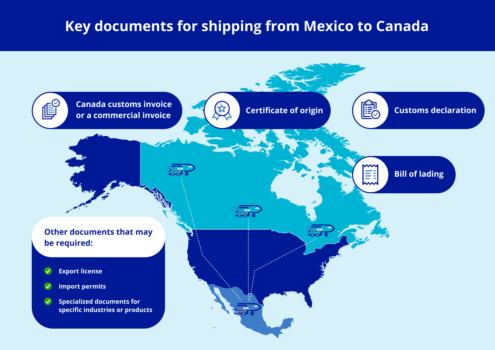Riding the wave of Mexico nearshoring: Shipping to Canada
As companies seek to capitalize on shifts in production chains, many have already begun to leverage the potential of Mexican manufacturing to enhance their business operations. Mexico offers increased accessibility to skilled professionals, especially compared to the U.S. or China. It has good transport links, investment benefits and many trade agreements that make business easier for companies in North America.
A recent study from S&P Global Mexico Manufacturing PMI surveyed around 350 manufacturers in Mexico. One- third of them forecasted growth opportunities as a result of nearshoring trends. This was in response to the widespread disruption of supply chains across borders brought post COVID-19.
Some of the most compelling reasons for shifting production to Mexico include shorter transit times, being in the same time zone, lower labour costs compared to China and advantageous taxation under the Canada-United States-Mexico Agreement (CUSMA). This is especially true for companies in the technology, electronics, consumer goods, textile and healthcare sectors.
In this article, we’ll dive into the opportunities and strategies involved in shipping from Mexico to Canada, including:
- What is nearshoring?
- Mexico’s role in North American trade
- The regulatory landscape: Advantages of the CUSMA for North American businesses
- How to nearshore and expand your business with confidence
- Key documents for shipping from Mexico to Canada
- FAQs for shipping from Mexico to Canada
- Purolator’s cross-border advantages
What is nearshoring?
Nearshoring or friendshoring is the practice of outsourcing business or production to nearby countries. Practicing business shipping from Mexico to Canada has many advantages, including cultural similarities, cost efficiency, shared time zones and faster shipping times.
Nearshoring is a supply chain management strategy that can mitigate risks associated with offshore sourcing. Learn more from our recent Ask an Expert interview with Stefania Blasi, Purolator’s Director of Industrial Sales and Strategy. Learn more
Mexico’s role in North American trade
Mexico offers a unique business opportunity due to its strategic location and favourable trade relationships. With a 3,138-kilometer-long border shared with the U.S., spanning four U.S. states and six Mexican states, Mexico has a close proximity to the North American market.
Border cities in Mexico have already established strong trade connections with the U.S. Here are some essential stats that paint a picture of how these connections can be strengthened even further:
- Approximately 76% of all truck and rail trade across the Texas-Mexico border occurs between Mexico and the U.S.
- As of 2023, manufacturing exports make up around 40% of Mexico’s $1.3 trillion economy.
Moreover, several border cities in Mexico have also started considering Canada as one of their top export markets. These growing relationships mean reliable transport from Mexico to Canada is becoming more accessible.
Explore seamless cross-border shipping from Mexico to Canada. Connect with our shipping experts for tailored solutions to enhance your supply chain and boost profits. Connect with shipping expert.
Mexico is home to various “manufacturing clusters” in industries such as technology, medical devices, automotive, electronics and aerospace. These clusters provide a conducive environment for businesses looking to establish manufacturing operations or source suppliers in Mexico. In particular, the IMMEX Program in Mexico allows foreign-owned facilities to temporarily import raw materials, as long as the resulting products are subsequently exported. This program offers economic advantages for U.S. and Canadian businesses that have nearshored to Mexico.
To navigate trade requirements and regulations, Mexican businesses can partner with reputable North American export companies specializing in Mexico-to-Canada logistics. Through these partnerships, Mexican businesses can access the Canadian market and unlock new avenues for growth.
The regulatory landscape: Advantages of the CUSMA for North American businesses
As some businesses look to nearshoring and shift their production from China to Mexico, it’s crucial to be aware of the regulatory landscape governing exports between Canada and Mexico. The regulatory framework is shaped by the CUSMA, a free trade agreement among the three countries that came into effect on July 1, 2020, replacing North American Free Trade Agreement (NAFTA).
Here are some key benefits of business shipping from Mexico to Canada thanks to the CUSMA:
- Preferential tariff treatment: Mexican goods qualify for preferential tariff treatment upon entering Canada or the United States. This ensures competitive advantages and cost savings for Mexican businesses.
- Streamlined cross-border transitions: CUSMA reduces costs and simplifies cross-border trade processes. It prohibits customs duties on digitally distributed products, enhances protection and enforcement of intellectual property rights, promotes fair treatment in cross-border services and encourages regulatory compatibility and cooperation.
- Reduced red tape: The agreement introduces new procedures such as e-signatures and self-certification of origin, making trade smoother for busy small businesses.
- Increased de minimis thresholds: Mexican businesses exporting to Canada can include a higher percentage of non-originating components in their products without losing preferential treatment under the trade agreement. This flexibility expands opportunities for Mexican exporters.
- Automotive trade regulations: Under CUSMA, new regulations are established for shipping automobiles and automotive parts. The minimum requirement for components manufactured within the participating countries increases from 62.5% under North American Free Trade Agreement (NAFTA) to 75% under CUSMA.
- Intellectual property protections: CUSMA strengthens intellectual property rights and prohibits tariffs on digital music, e-books and other similar digital products. It also establishes copyright safe harbor for internet companies, providing protection against copyright infringement liability when they make good faith efforts to combat infringement.
- Sustainability: The CUSMA includes conservation commitments and has already encouraged collaboration between Mexico and Canada on sustainable forest and fishing management. Additionally, combined efforts in urban planning, sustainable water and water treatment, healthcare programs and more will help Mexico become an even stronger and more sustainable economic partner within this agreement.
By better understanding the CUSMA and taking advantage of the regulatory environment it has established, North American businesses can fully capitalize on the benefits of nearshoring from Mexico and strengthen their supply chains.
The agreement also presents new logistics solutions for small to medium size Canadian business owners. These businesses now have a chance to expand in cost-effective and sustainable ways. The key is finding a supportive logistics partner with expertise in shipping from Mexico to Canada as well as an extensive Canadian delivery network. The reduced red tape and streamlined cross-border transition that the CUSMA facilitates means opportunity is on the horizon for businesses of all sizes looking to ship from Mexico to Canada.
These recent facts and statistics highlight the strengthening economic ties between Mexico, Canada and the U.S.:
- In the first three months of 2023, foreign direct investment in Mexico experienced a remarkable 48% surge compared to the same period in 2022.
- In the first quarter of 2023, Canada and the United States invested a significant amount of money in Mexico’s manufacturing sector—notably 5 out of every 10 new dollars invested in Mexico during that time came from Canada and the United States.
- IT hardware manufacturing, electric vehicle supply chain and sustainable technology business drove $22 billion USD in nearshoring growth.
- Significant growth in Mexico’s medication and medical device exports to the U.S. shows Mexico’s reliability and sustainability as a nearshoring partner and helps diversify and strengthen their export economy overall.
How to nearshore and expand your business in Canada with confidence
A strong Mexico-Canada logistics strategy is an essential component for a North American-based supply chain. Here are some key considerations for businesses when shipping from Mexico to Canada.
Key documents for shipping from Mexico to Canada
Having the necessary paperwork readily available can help prevent delays at the border and ensure a smooth transit for your shipments. Here are the key documents you’ll need to prepare when exporting from Mexico to Canada:
- Canada customs invoice or a commercial invoice: This document provides details about the goods being shipped, including their description, quantity and value. It is essential for customs clearance and helps determine the applicable duties and taxes.
- Certificate of origin: This document verifies the country of origin of the goods and is crucial for claiming preferential tariff treatment under trade agreements like CUSMA. It demonstrates that the goods meet the required criteria for preferential treatment.
- Customs declaration: This document provides information about the goods, their value and the parties involved in the transaction. It helps customs authorities assess the appropriate duties and taxes and ensures compliance with customs regulations.
- Bill of lading: This document serves as a receipt of goods and provides details about the shipment, including the carrier, origin and destination. It is essential for tracking and tracing the shipment throughout its journey.
- Other relevant documents that may be required: Depending on the nature of your goods or specific industry requirements, additional documents may be necessary. These may include:
- Export license: Some goods may require an export license from the Mexican government before they can be shipped to Canada.
- Import permits: Certain goods, such as controlled substances or agricultural products, may require import permits from Canadian authorities.
- Specialized documents for specific industries or products: Certain industries or products may have unique documentation requirements. For example, medical devices may require additional certifications or registrations.
Helpful tools for easy customs compliance
Learn more.
FAQs for shipping from Mexico to Canada
For businesses in Mexico that are manufacturing goods and considering shipping to Canada, here are some frequently asked questions (FAQs) to help you navigate the logistics and regulatory aspects of the process.
Purolator offers 100% Canada-wide coverage to help you access remote areas and untapped markets. By leveraging the benefits of nearshoring to Mexico and partnering with a reliable and trusted shipping provider, like Purolator, North American businesses can:
- Strengthen their supply chains.
- Optimize their shipping processes.
- Overcome supply chain bottlenecks.
- Make importing into Canada from the United States seamless.
- Tap into the vast potential of the U.S. and Canadian market.



